Panasonic NA148XS1 Review
Panasonic NA148XS1 Review
An easy to use machine with great features at a good price
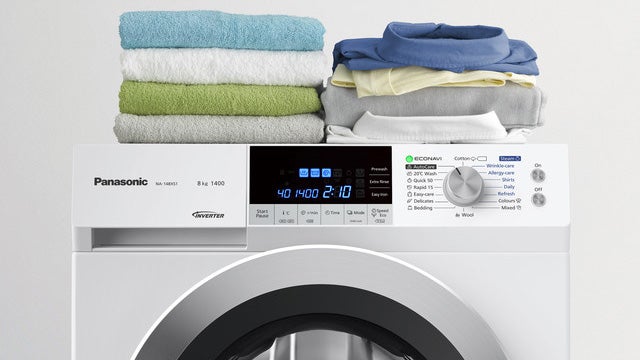
Verdict
Pros
- Exceptionally economical
- Quiet wash and spin
- Comprehensive steam features
Cons
- Not the best at stain removal
- Poor spin efficiency in Eco mode
Key Specifications
- Review Price: £599.00
- 8kg capacity drum
- A+++ energy rating
- 1400rpm spin
- Steam function
- Automatic wash sensor
What is the Panasonic NA148XS1?
The NA148XS1 is one of Panasonic’s flagship washing machines and boasts the sort of feature list normally seen in pricier machines. This is a full ECONAVI sensor machine that on certain programs will adjust every single wash parameter based on the weight, type and soiling of the load. Just add dirty clothing and washing powder.
With useful add-on functions like steam action, wrinkle care and anti-allergy cycle, an 8kg capacity and 1,400 spin speed, this Panasonic offers top-end features throughout and promises to be one of the year’s best washing machines – at least on paper.
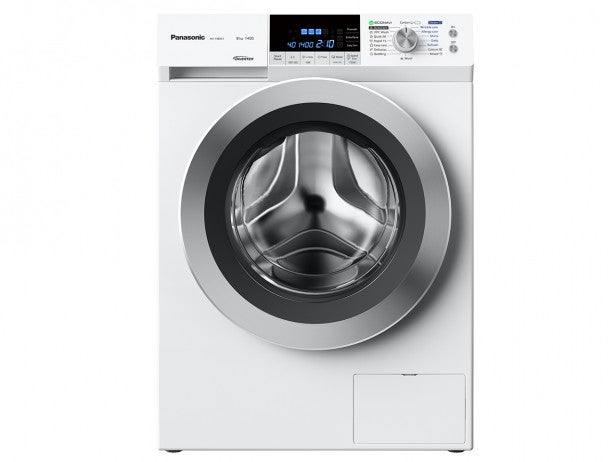
Panasonic NA148XS1 – What is it like to use?
While some brand’s flagship washing machines are complex and require a manual the size of the Birmingham telephone directory, Panasonic has gone to great lengths to make the NA148XS1 as easy to use as possible.
The rotary programme selector makes a lot of sense, the separate on and off buttons are inspired and add-on features are accessed through a row of buttons beneath the display. The display itself features bright blue icons and information on temperature, spin speed and duration displayed in numbers so big and bright they could probably be read from the next county.
In its traditional position bottom-right, is a fluff and coin filter that Panasonic recommends checking and cleaning regularly. With its large porthole door, 8kg capacity and equally traditional top-left soap drawer, this Panasonic could not be more straightforward to use.
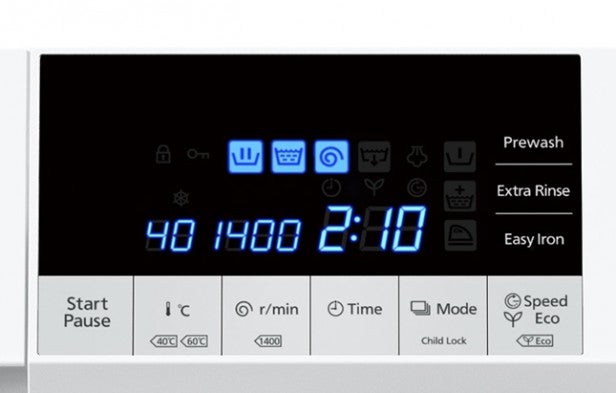
Key to the Panasonic’s real charms is its ECONAVI Autocare system. This takes wash sensing to the next level by measuring incoming water temperature, load weight, soiling level using an optical sensor and the type of material mix (the ratio of synthetics to cottons in the load).
From there, some washing machine maths goes on and the NA148XS1 tweaks the water consumption, temperature, soak time, amount of detergent, number of rinses, spin speed and duration to create the perfect cleaning regiment.
Not only does this make programming your washing machine pretty much ‘insert clothes and press go’, it also lets the machine use the lowest amount of water and energy required for the specific wash load you have placed in its capacious drum.
As you will see from the test results further down, the ECONAVI AutoCare setting more than delivers on its Eco credentials, making this our favoured default setting for most washes.
Panasonic NA148XS1 – How noisy is it?
Panasonic has been impressing us with super quiet machines since the first model we tested from the brand over two years ago. While the company doesn’t claim any high-tech motor technology or drive system, the NA148XS1 continues the trend with whisper quiet washing at just 53dB and a very quiet spin at 74dB – exactly what the EU energy label states, which is less common than you’d imagine.
The wash noise is particularly good and compares favourably with competitors. 53dB is no louder than light rain outside (not with an umbrella up, obviously) and 74dB is no louder than light traffic.
Moreover, this Panasonic produces a very consistent level of noise throughout the wash and spin, with no pops or clicks of valves or relays to disturb pets or children grabbing a crafty nap in your kitchen.
Panasonic NA148XS1 – What programmes does it have?
If you want to take more manual control of your washing the NA148XS1 offers a good spread of material specific programmes too, 15 to be exact. These cover your basic cottons, delicates, wool, colours and bedding, as well as an ultra-cool 20-degree wash and 15 and 50 minute quick washes.
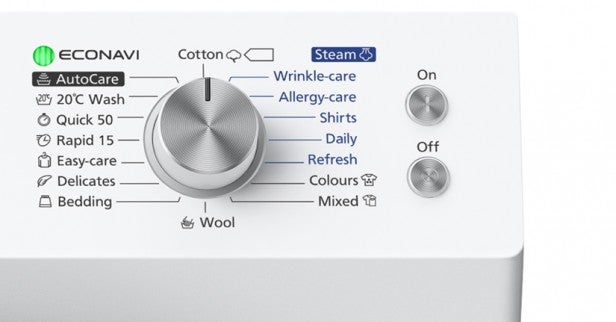
Five of the programmes combine the Panasonic’s advanced steam function. There are also three wash plus steam programmes, two of which are specifically for light loads (2kg) of shirts or casual wear. These use steam towards the end of the wash and promise to reduce creasing or, with some garments, eliminate it all together.
The third wash and steam programme is Panasonic’s anti-allergy cycle and is ideal for garments that touch bare skin when worn, so ideal for babies or those with sensitive skin. The steam penetrates the fabric, killing off dust mites and bacteria as well as removing particles of pollen.
Unusually, this feature is available on loads up to a fairly hefty 5kg, so plenty of clothes can be treated in this way. The steam ensemble of programmes is complete with two steam only cycles, refresh and wrinkle care, aimed at quickly sprucing up small loads (up to 1.5kg) without going for a full wash.
Panasonic NA148XS1 – How well does it wash?
This Panasonic performed well in our wash tests, although its stain removal abilities are not the best we’ve seen and it is not the most efficient at spinning out water after the wash.
In our main 80% load (6.4kg) test on the UK’s most favoured programme, cottons at 40 degrees, we placed a stain strip in the wash featuring dried on ketchup, juice, turmeric, engine oil, blood and red wine, and used a leading non-biological detergent.
 Left to Right: Ketchup, juice, tumeric, engine oil, blood, red win
Left to Right: Ketchup, juice, tumeric, engine oil, blood, red win

Typical of modern machines, the lengthy cycle took over two and half hours but only used just over 1kW of electricity and 56 litres of water. Examining the stain strip, the juice, blood and red wine stains were removed completely, but there was still a shadow where the ketchup had been.
The turmeric and engine oil will never be removed completely without bio powders, but the Panasonic didn’t make much of a dent on either with non-bio. The cleaning result is average for a machine of this price – much better than budget machines, but not as good as some other brands, admittedly more expensive, flagship models.
In a series of other wash load tests we ran the same 80% load using the Panasonic’s ECONAVI/Autocare programme, and got superb results for economy of resources. While the load was not heavily soiled (so the sensing technology would reduce energy, run time etc), the same load finished 45 minutes quicker and used half the electricity of the cottons wash.
The only downside was that in an effort to reduce electricity the spin cycle was reduced, leaving almost 50% of load weight in water in the end wash. That means the clothes will take much longer to air dry or tumble dry.
As a half load test we use 40% of capacity or 3.2kg of washing. This is still a fair pile of clothes, particularly cottons. We ran standard cotton at 40 degrees and an Eco wash with this load, and once again Panasonic’s sensor technology had a dramatically positive impact on energy use.
The standard half load used just under 1kW while the Eco wash drew just 300W. Like the full wash however, the time and water used was almost identical and the spin efficiency took a real hit. On the standard half load wash some 38% of wash weight in water remained, which is about average, while in Eco it was a whopping 53%.
This is noticeably more than some machines and means your clothes will take longer to dry, especially when air-drying. A machine like the Samsung WW80H7410EW left 22% less water in a half load of clothes on its Eco mode, the equivalent of 700g or more than a pint. That’s a big difference and the Panasonic’s eco run used around the same amount of electricity.
The steam modes are a little more difficult to test, but we tried several shirts on the shirts wash and steam cycle and a fleece that had been exposed to bonfire smoke on the steam only refresh programme.
The shirts came out clean, but we didn’t really see a great deal of a difference in the level of creasing compared to the same garments in a normal wash. The fleece was a tougher test and while the Panasonic certainly freshened it up, a feint smoke smell was still present. With lighter garments results would no doubt be better still.
Panasonic NA148XS1 – How much will it cost to run?
With sensor machines, it is very difficult to accurately predict how much a machine will cost to run as they adjust the number of resources used relative to your washing habits and level of soiling. Our standard calculations are based on 240 cycles per year, with around 200 full loads and 40 half loads with a 50/50 split between standard washes and Eco.
Using this ratio of washes, Panasonic’s claim the machine offers 40% better than A+++ performance is actually a little modest. This is one of the most economical machines to run that we have ever tested.
At just over 200kWh per year, running costs in electricity will be just over £30, which is around £5 better than many other A+++ machines we have tested. Water consumption is also impressive with the same year’s washing likely to use around 13 cubic metres of water – or about £20 for those on metered water.
Not only is Panasonic’s NA148XS1’s asking price reasonable for a well specified fully featured flagship machine, its low running costs are among the best we have tested.
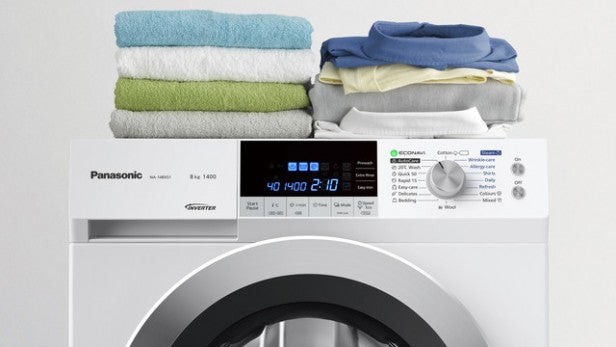
Should I buy the Panasonic NA148XS1?
The Panasonic NA148XS1 is a superbly featured machine, easy to use and is exceptionally economical to run. This is offset a little by its so-so stain removal performance and poor spin efficiency in Eco modes.
If you are happy to use biological powders to shift stains and have plenty of time and space to dry clothes, the NA148XS1 is a great buy. But there are machines at this price that edge it in other areas, so check our best washing machines list before buying.
Verdict
A very good machine, but not quite the best at this price.
Trusted Score
Other
| Testing Note | *Annual figure based on the average UK household running 200 x 40°C 80% max loads (50/50 split normal & ECONAVI) and 40 x 40°C 40% half loads (50/50 split normal & super eco). Average UK electricity costs based on 15p / kWh. |
Key Features
| Drum Capacity | 8kg |
| Energy Rating | A+++ |
| Approx. Annual Running Cost | £31.48 |
| Approx. Annual Power Consumption (KWh) | 209 kWh |
| Approx. Annual Water Consumption (ltrs) | 13,220 litres |
Standard Wash: 80% Load
| Power Consumption (KWh) | 1.264 kWh |
| Cost Per Wash at 15p/KWh | 19p |
| Water Consumption | 58.4 litres |
| Time to Completion | 2 hours, 33 minutes |
| Noise During Wash (dB) | 53dB |
| Noise During Spin (dB) | 74dB |
| Moisture After Spin | 1.9kg (30%) |
Standard Wash: 40% Load
| Power Used (KWh) | 0.999 kWh |
| Cost of Wash at 15p/KWh | 15p |
| Water Use (Litres) | 43 |
| Time to Finish | 2 hours, 16 minutes |
| Noise During Spin | 74dB |
| Noise During Wash | 53dB |
| Moisture After Spin (kg) | 1.2kg (38%) |
Eco Wash: 40% Load
| Power Per Wash (KWh) | 0.284 kWh |
| Cost Each Wash at 15p/KWh | 4p |
| Water Consumption (Litres) | 44.5 litres |
| Time to End | 2 hours, 18 minutes |
| Noise (Wash Cycle) | 53dB |
| Noise (Spin Cycle) | 74dB |
| Moisture Post Spin (kg) | 1.7kg (53%) |


